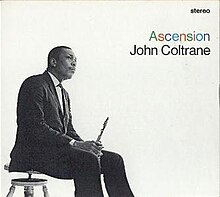Ascension (John Coltrane album)
| Ascension | ||||
|---|---|---|---|---|
 |
||||
| Studio album by John Coltrane | ||||
| Released | February 1966 | |||
| Recorded | June 28, 1965 at Van Gelder Studio, Englewood Cliffs | |||
| Genre | Free jazz, avant-garde jazz | |||
| Length | 40:49 (Edition II) 38:30 (Edition I) 79:19 (CD release) |
|||
| Label | Impulse! | |||
| Producer | Bob Thiele | |||
| John Coltrane chronology | ||||
|
||||
| Professional ratings | |
|---|---|
| Review scores | |
| Source | Rating |
| Allmusic | |
| The Penguin Guide to Jazz |
|
| Rolling Stone Album Guide | |
| The Rolling Stone Jazz Record Guide | |
Ascension is a jazz album by John Coltrane recorded in 1965 and released in 1966. It is often considered to be a watershed album, with the albums released before it being more conventional in structure and the albums released after it being looser, free jazz inspired works. In addition, it signaled Coltrane's interest in moving away from the quartet format. Coltrane described Ascension in a radio interview as a "big band thing", although it resembles no big band recording made before it. The most obvious antecedent is Ornette Coleman's octet (or "double quartet") recording, Free Jazz: A Collective Improvisation, which—like Ascension—is a continuous 40-minute performance with ensemble passages and without breaks. Jazz musician Dave Liebman, commenting on Ascension, recalled that the album was the "torch that lit the free jazz thing".
Coltrane's horn section is moored to a monolithic rhythm section, centered on pianist McCoy Tyner, double bassists Jimmy Garrison and Art Davis, and drummer Elvin Jones. On Ascension (and unlike on Coleman's Free Jazz), group ensembles alternate with solos, and take up about equal space. The basic theme stated in the opening and closing ensembles is a variation on the major motif of Coltrane's previous album A Love Supreme (1965), particularly the opening bass riff stated on said album's opening track, "Acknowledgment".
Coltrane gave the musicians no directions for their solos, other than that they were to end with a crescendo. The ensemble passages are more structured. There were chords, but apparently they were optional; it is more accurate to say that the ensembles consist of a progression of modes rather than chords, with mode changes signaled by Coltrane, pianist McCoy Tyner, and trumpeter Freddie Hubbard. By comparison to Free Jazz, Ascension features a much expanded "front line", with two altos, three tenors, and two trumpeters.
...
Wikipedia
